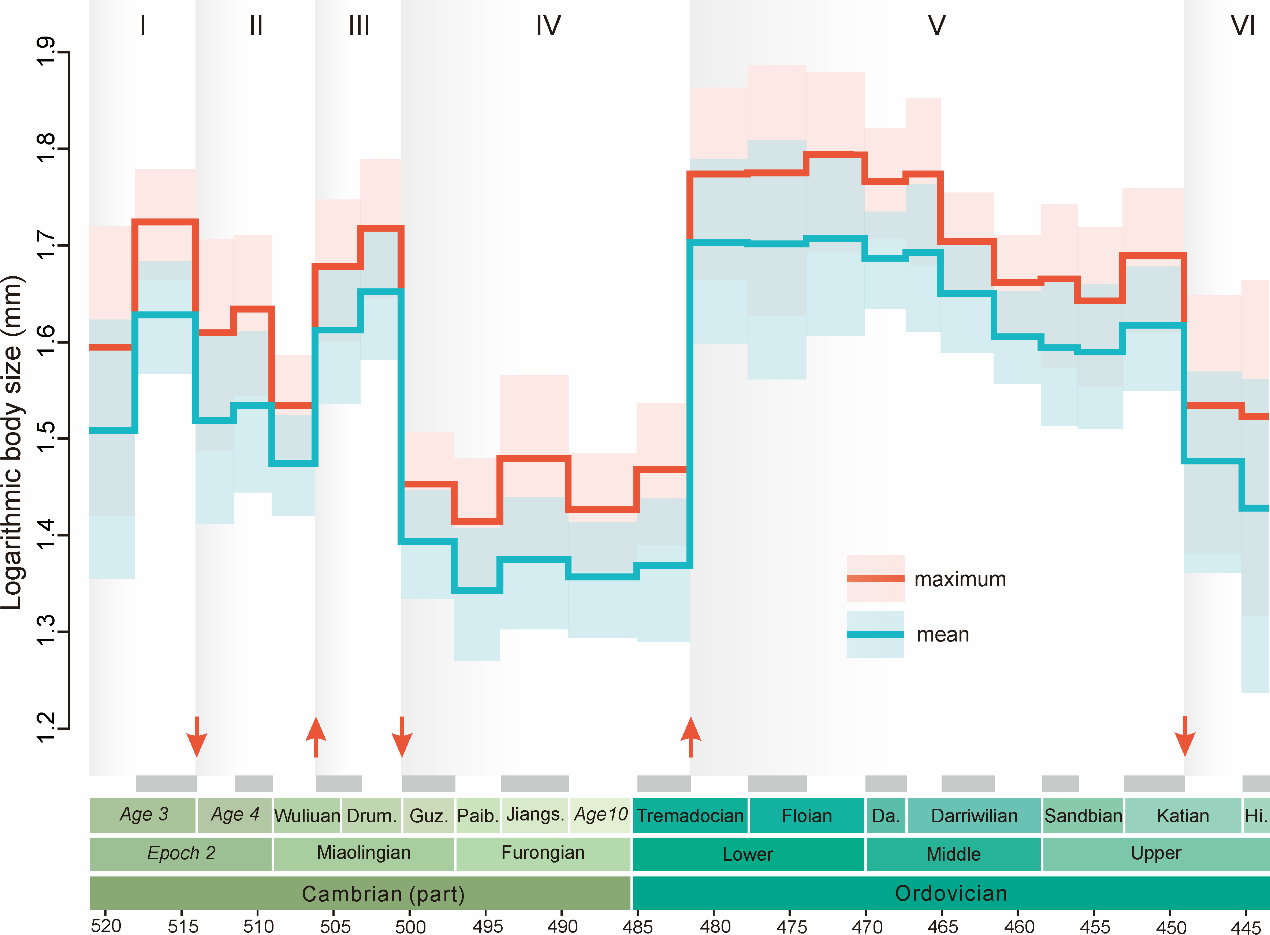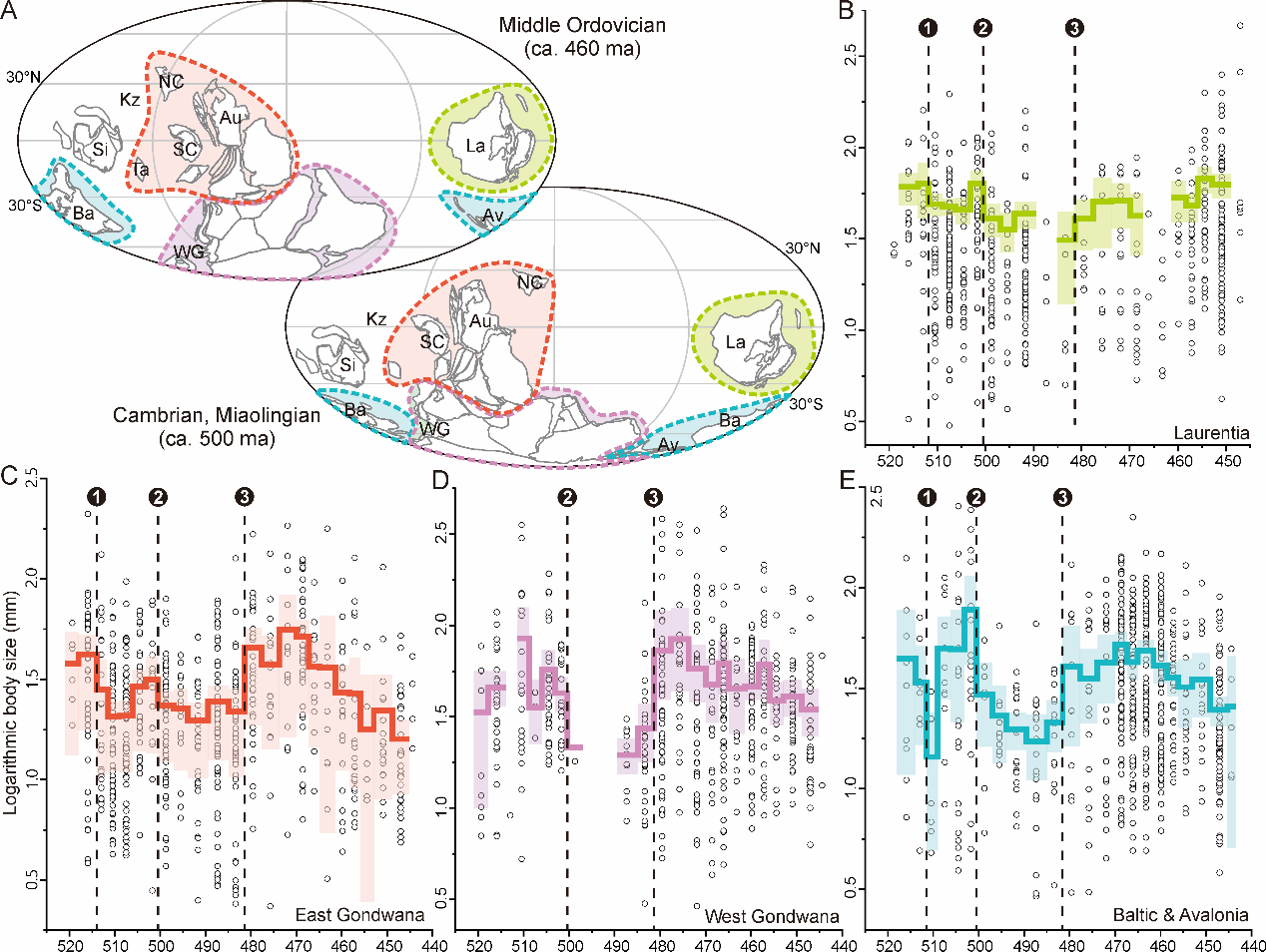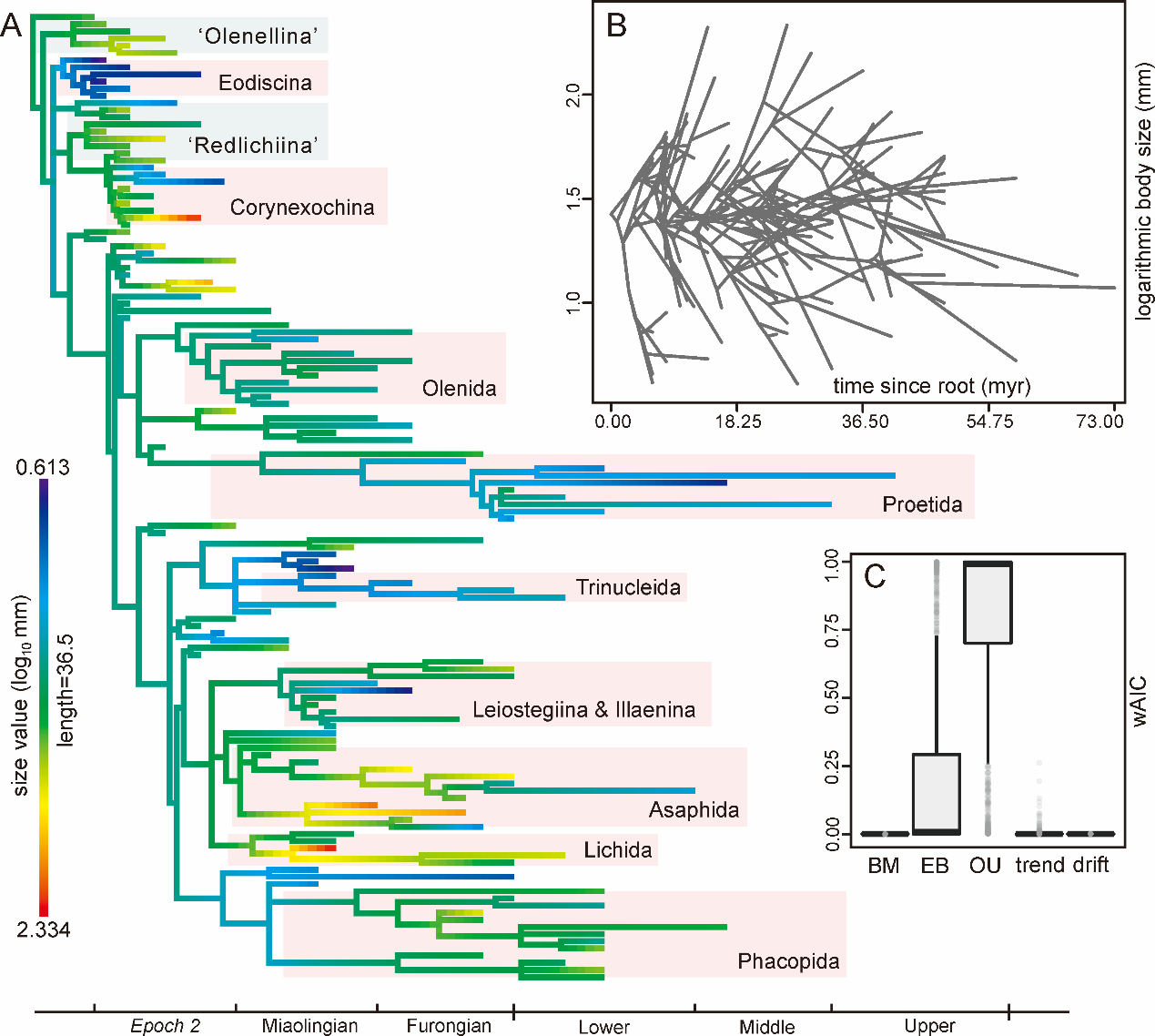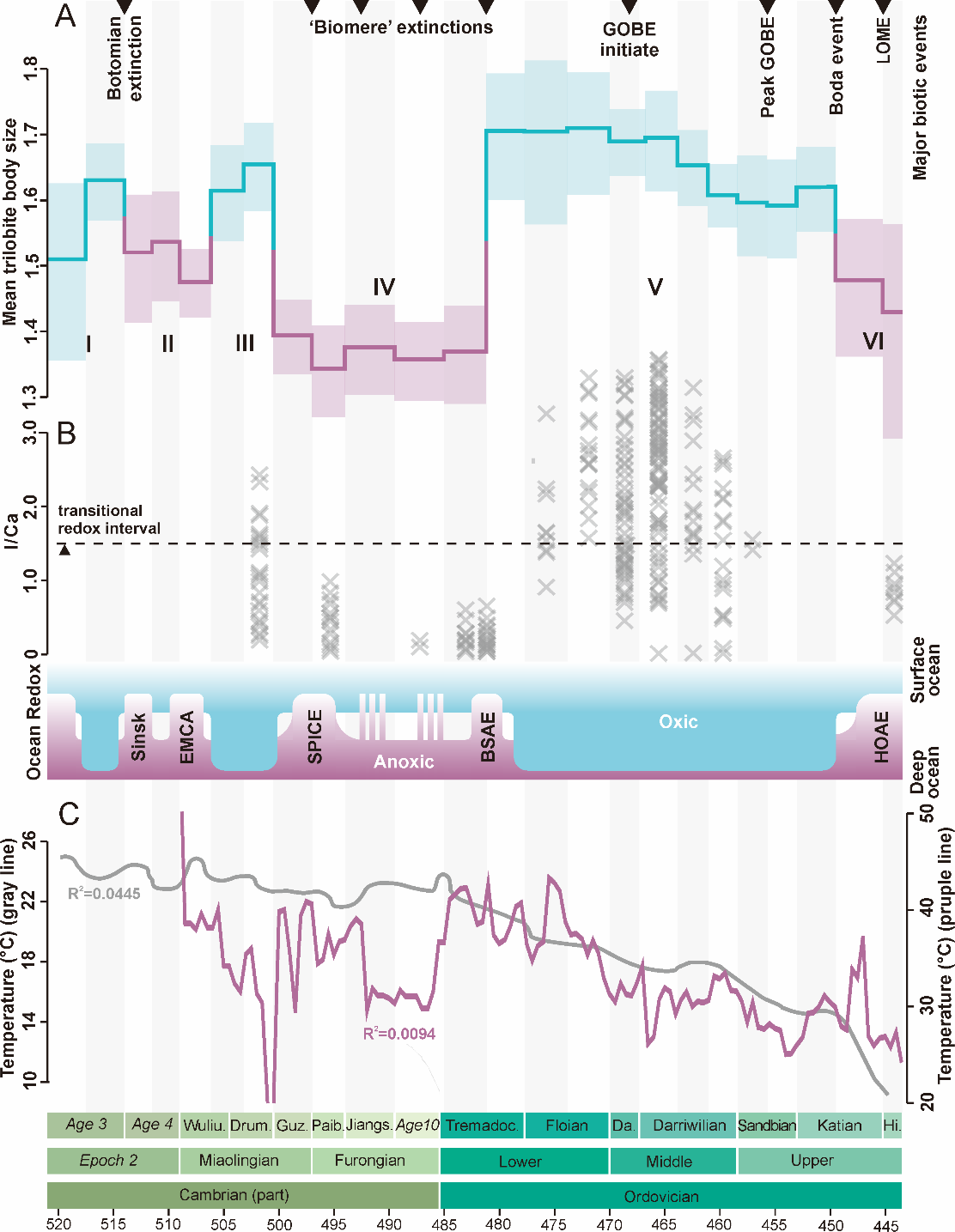A recent study shows that marine oxygen levels were crucial to the evolution of Early Paleozoic trilobite body size, suggesting that oxygen may have influenced the evolution of other animals’ body size as well.
The research, involving a comprehensive analysis of body size evolution in trilobites—a highly representative group of fossil invertebrates—was led by Prof. ZHAO Fangchen and Prof. ZHU Maoyan from the Nanjing Institute of Geology and Palaeontology of the Chinese Academy of Sciences. Results were published in Science Advances.
Patterns of animal body size evolution have long been a focus of scientific research, with different theories attempting to explain it. For example, Cope’s Rule holds that animal species tend to evolve to become larger over time. In contrast, Bergmann’s Rule states that in warm-blooded animals, like mammals and birds, species living in colder climates tend to be larger than those living in warmer climates. Both of these theories were developed in the 19th century.
Recently, some studies have emphasized the role of oxygen in animal body size evolution, but many of these studies are based on fossil vertebrates. Among invertebrates, research on body size evolution has been limited to a few groups, such as brachiopods and insects.
The Early Paleozoic is an ideal period for testing the relative importance of oxygen levels and other environmental mechanisms on body size, due to environmental fluctuations in marine oxygen levels, marine chemistry, and temperature during this epoch.
Trilobites have been a central focus of macroevolutionary studies—i.e., those involving large-scale changes in life forms rather than individual species—due to their long geological history, diverse ecological adaptations, and abundant fossil record. With adult body sizes ranging from ~2 mm (Acanthopleurella stipulae) to more than 700 mm (Isotelus rex or Ogyginus forteyi), they are an ideal clade for testing the evolutionary dynamics of body size. Additionally, few comprehensive assessments have been done on the evolution of body size in giant trilobites, despite long-standing interest in them.
To explore the macroevolutionary potential of trilobites, the researchers compiled an extensive dataset of body size for Cambrian and Ordovician forms, covering 1,091 genera and representing over 90% of trilobite families during this period. They examined the role of marine oxygen and temperature in determining evolutionary trends in trilobite size. Their results highlight the long-term impact of marine oxygen levels on the evolution of trilobite body size, further confirming the significant role oxygen played in shaping the evolutionary dynamics of early metazoans.
The dataset shows that the body size patterns of trilobites during the Cambrian and Ordovician periods can be divided into six phases (I-VI), with body size changes concentrated in five brief events: in early Age 4 (ca. 514 Ma), the late Wuliuan (ca. 506.5 Ma), the Guzhangian (ca. 500.5 Ma), the late Tremadocian (ca. 480 Ma), and the late Katian (ca. 450 Ma).
The size differences across the six phases are significant—they are not the result of sample size differences across intervals. Major size changes occurred in each major geographic region, particularly during Age 4, the Guzhangian, and the middle Tremadocian, suggesting that global patterns mirrored regional trends. Collectively, these results imply that changes in trilobite body size were more likely to be influenced by global rather than regional factors.
To investigate whether the episodic changes in body size obscure an underlying directional pattern, the researchers identified trends in average body size across the 24 most diverse trilobite families. Most well-sampled trilobite families showed no significant size changes through time, ruling out Cope's Rule at the family level. Moreover, the researchers reconstructed and plotted ancestral body size onto family-level phylogeny, fitting five different models of continuous trait macroevolution.
The results indicate that most trilobite families were near the average size, with some clades independently evolving to larger or smaller sizes during different ages. However, none of the results support an overall trend in body size evolution. Overall, these analyses reveal no preferential direction in trilobite body size during the Cambrian and Ordovician periods that would support Cope’s Rule.
In contrast, trilobite size was strikingly correlated with fluctuations in marine redox (i.e., marine oxygen levels), especially during the well-known anoxic events of this interval. For example, reductions in trilobite size during the early Cambrian Age 4, the Guzhangian, and the late Katian correspond with the Sinsk, SPICE, and HOAE anoxic events. The miniaturization phases after Sinsk and SPICE (phases II and V) also coincided with sustained marine anoxia. Furthermore, the end of the persistent Black Shale Anoxic Event (BSAE) in the late Tremadocian may have triggered the most pronounced increase in trilobite size.
From the late Tremadocian, trilobite size remained stable for nearly 30 Myr (phase V), coinciding with the expansion of marine oxygenation. In contrast, although global cooling may have triggered the extraordinary Great Ordovician Biodiversity Event (GOBE), estimates of early Paleozoic temperature changes show little correlation with trilobite body size. In short, trilobite body size changes during the Cambrian and Ordovician periods correspond closely with marine redox fluctuations.
It is reasonable to assume that marine redox influenced, if not directly controlled, trilobite body size changes across the world since larger bodies need more oxygen and smaller bodies need less. All in all, this study strongly supports a model in which oxygen levels constrained body size evolution in trilobites—whose size evolution, along with that of other marine metazoans, has not been understood as well as that of terrestrial clades.
Furthermore, the study provides independent support for the hypothesis that oxygen was an important driver of early animal evolution more generally and may have influenced the body size evolution of other clades as well.
This research was supported by the National Key Research and Development Program of China and the National Natural Science Foundation of China.

Fig.1: Tempo and mode in the body size evolution of Cambrian-Ordovician trilobites. Changes in maximum size (red) and mean size (blue) for each time slice, with lines and shading representing the mean value and 95% confidence intervals. Discrete episodes of body size change are marked by red arrows, and these events demarcate six distinct phases.

Fig. 2: Body size evolution of Cambrian-Ordovician trilobites in Laurentia (B), East Gondwana (C), West Gondwana (D), Baltica and Avalonia (E). Three episodes of change in body size during Cambrian Age 4, the Guzhangian and middle Tremadocian are marked 1, 2 and 3.

Fig. 3: Phylogenetic based family-level body size evolution in Cambrian-Ordovician trilobites. (A) Ancestral state reconstruction of body size. (B) Evolutionary traitgram of trilobite body size. (C) Model-fitting results expressed as Akaike weights for five different evolutionary models.

Fig. 4: Cambrian and Ordovician trilobite body size (A) and their correlation to the inferred oxygen levels (B) and temperature (C). (B) Ocean redox conditions and widespread anoxic intervals, showing strong links between trilobite body size and marine redox changes, blue and purple indicate oxic and anoxic states, respectively. (C) Temperature curves are based on bulk-rock (purple line) and skeletal material (gray line) δ18O datasets.
Download:
